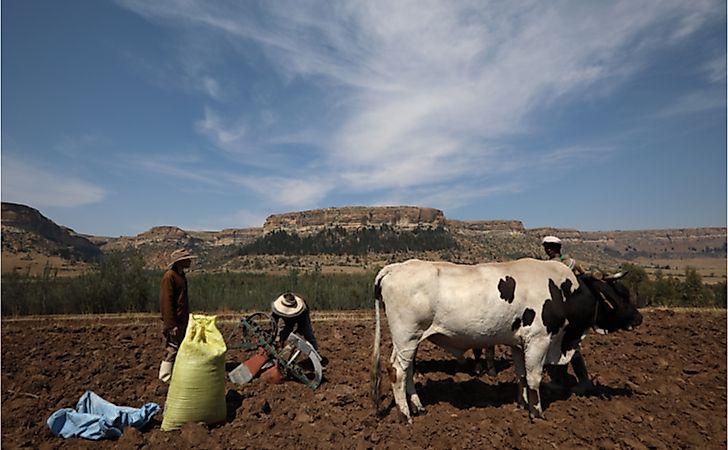What Are The Biggest Industries In Lesotho?

The Kingdom of Lesotho is an enclaved country surrounded by South Africa. It covers an area of approximately 11,583 square miles and has a population of around 2 million people. Previously a British Crown Colony, Lesotho declared independence from the UK on October 4, 1966. The name “Lesotho” translates to “the land of the Sesotho people.” Lesotho is a constitutional monarchy with a ceremonial king and a prime minister who is the head of government. The country is a member of several international organizations including the African Union, the United Nations, SADC, and the Commonwealth. Lesotho’s location makes the country vulnerable to economic development and political activities in South Africa.
Overview Of The Economy Of Lesotho
Because of its geographical location, the economy of Lesotho is integrated with the economy of South Africa. The country’s economy is mainly based on agriculture, mining, manufacturing, livestock, and remittance of workers from the Southern African Customs Union. Most of the households are engaged in subsistence agriculture. Almost half of the population derive their income from informal crop cultivation and animal husbandry. The majority of the female workers are employed in the apparel sector with Lesotho being the largest exporter of garments to the US in Sub-Saharan Africa. Over the years, Lesotho has progressively moved from a subsistence-oriented economy to a lower-middle-income economy and is currently exporting manufactured products and natural resources. The export sector is a major source of income for a significant number of people. Lesotho has a wide variety of industries that have played crucial roles in the country’s economic growth. Here are some of the biggest industries in Lesotho
Agriculture
Agriculture is the most important sector of Lesotho’s economy and accounts for about 57% of the total labor force. Agriculture is mainly subsistence and practiced by the rural poor who are the country’s majority. Most of the farms are located in the western lowland which receives plenty of rainfall and has sufficient fertile soil. The farms are located in small villages far from the major roads and the products from the farms are consumed locally with surplus shipped for sale, especially to South Africa. Over the past years, Lesotho’s economic structure has changed significantly with agriculture, which is a pillar of the economy, taking a downward trend since the early 1990s. Subsequently, its contribution to the GDP has been shrinking from 7.2% in 1994 to about 5% today. The major crops grown in the country are maize, sorghum, and wheat. Most farmers are also involved in animal husbandry to supplement crops and maintain food security, particularly during the drought season. Animals kept include sheep, goats, and cattle. Sheep and goats are important sources of meat, milk and quality wool. The constraints related to agriculture include weak extension services, limited use of technology, poor infrastructure leading to poor access to the market, and land degradation.
Mining
Lesotho’s significant mineral resources are water and diamond. Thus, the mining industry mainly comprises of diamond mining. Diamond is mainly produced in Mothae, Letseng, and Kao mines which had a combined estimated production of 24,000 carats in 2014. The mining of diamond in the country started in the 1950s. However, following independence, most of the mines were closed as a result of low production. The Letseng mine was reopened in 1968 and was again closed in the 1970s and only to be reopened in 2000. Since then, the mines have proved to be productive. Diamond production is mainly carried out by international firms on a commercial basis. Gem Diamonds of the UK own the Letseng Mine while Kopane Diamond Development Plc and Firestone Diamond Plc have had their activities at the Liqhobong Mine. Between 2010 and 2011, the export of diamond reached about US$ 230 million compared to US$ 300 million in 2014. Apart from diamond, other known minerals in Lesotho include clay, base metal, uranium, gravel, sand, and dimension stone. Coal reserve has also been identified but not exploited.
Tourism
The tourism industry in Lesotho is one of the fastest-growing industries in the country. The growth is attributed to the country’s diverse and unique features which makes it an attractive travel destination, especially for tourists from South Africa who make up about 90% of the tourists. Most of the tourists visiting Lesotho are attracted to its natural beauty, rich flora and fauna, and cultural heritage. The Government of Lesotho has identified the tourism industry as one of the major economic drivers and has invested resources to boost tourist arrivals to the country. In 2013, the industry contributed about 5.5% of the country’s GDP, with the proportion expected to rise to 6.1% by 2024. In the same year, the sector employed about 25,000 people (4.6% of the total workforce). Tourism activities are supervised and promoted by the Ministry of Tourism, Environment, and Culture.
Textile And Apparel
Lesotho’s textile and apparel industry accounts for about 20% of the country’s GDP and employs about 40,000 people, most of whom are women. The industry developed in the 1990s when Asians began to invest in the country. Garments were mainly produced and shipped overseas, mainly to the American and EU markets. When the African Growth and Opportunity (AGOA) was introduced in 2000, Lesotho became even more attractive to foreign investors and is currently the leading exporter of garments to the US in Sub-Saharan Africa. In 2008, it exported garments and textiles worth US$ 340 million. Apart from the US, Lesotho also exports textile to South Africa and other SADC countries duty-free.











